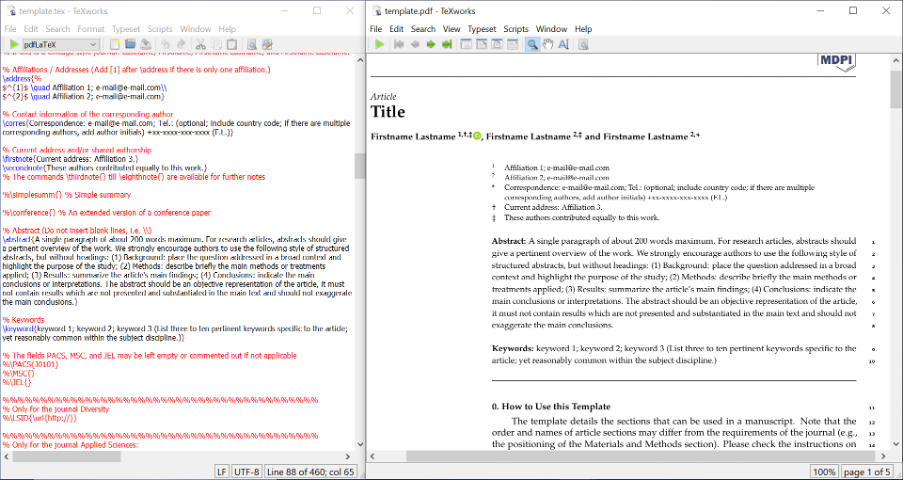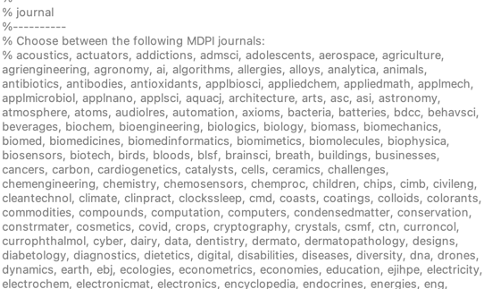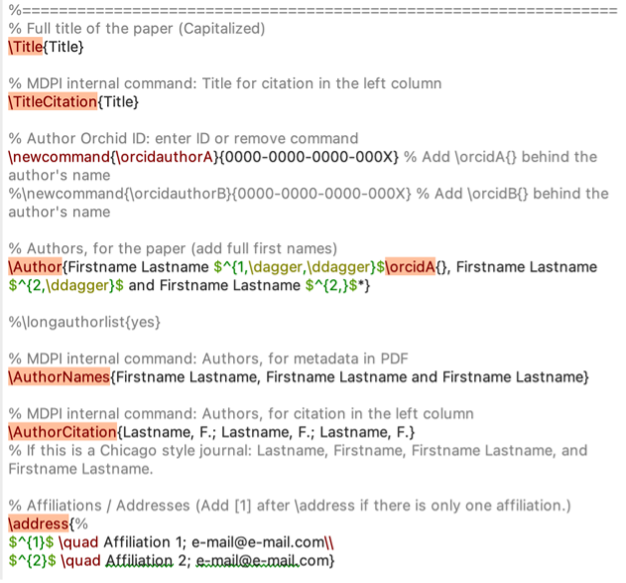
How to Format a Manuscript for MDPI Submission Using LaTeX
Using LaTeX to prepare your research paper may leave you feeling confused as there’s a lot of coding involved. Worry no more. This article will walk you through the basics of LaTeX, as we carefully explain the first steps, including how to format a manuscript. We also speak to two of our in-house LaTeXperts provide advice and include their takes on this popular manuscript preparation software.
Software
To use LaTeX, you need to download software to compile it.
 The MDPI LaTeX template, shown in TeXworks software.
The MDPI LaTeX template, shown in TeXworks software.
You can use the following software to prepare your LaTeX file. Make sure you update the software if it’s already on your system, and use the newest version available online.
- TeX Live
- Overleaf
- MiKTeX
Overleaf will allow you to create and edit your file online, whereas the others require downloading.
Template
Your LaTeX paper must be formatted in line with MDPI’s house style. MDPI’s house style involves many different things—such as sizes of fonts, the correct alignment of various sections, and the journal’s logo. This ensures that the presentation of papers is identical across the board.
This means using MDPI’s LaTeX template. The template is updated regularly, so make sure that you have the latest version. So how to format a manuscript becomes as simple as using this template.
Here’s how it works. The power of coding allows the LaTeX system to transmit important information about the presentation of the document. This then appears as a complete and formatted research paper in the corresponding window.
When using the software of your choosing, it’s easy to import the MDPI LaTeX template into the software. You can then use the LaTeX software to open the template.
The first thing to note is that the grey font on the left cannot be seen in the final composition on the right. The grey font merely acts as a way for the author and MDPI staff to communicate. The black font codes for information which is seen in the final paper.
![]()
Having said that, the first black line that you will see is the above. As the author, it is your responsibility to edit these fields separated by commas.
Underneath this, you will see a large amount of text in grey, headed by “Class Options:”.

These separate paragraphs provide instructions on how to fill out the fields in the \documentclass line shown above.
For example, “journal” in
![]() can be replaced with any of the journals shown here in grey:
can be replaced with any of the journals shown here in grey:

Next, the information below in black must be filled out.

The title, Orcid iD, and author names can be added here.
The rest is the manuscript itself—all of the sections necessary—are already featured in the template. As such, you can write up your manuscript directly into the template, or copy and paste the sections in.
Introducing our LaTeX experts
Many authors find LaTeX complicated the first time that they use it. Here, two of our in-house experts provide insight and advice for LaTeX users, specifically on how to format a manuscript.
Jing Chen is a Production Editor and answers authors’ questions about LaTeX sent to latex@mdpi.com.
Tim Jackman is MDPI’s Editing Technology Specialist, and supports the English editing team with LaTeX use.
Do you have any information and/or advice for authors using LaTeX?
Jing Chen: LaTeX is a micropackage running on top of a TeX programme. LaTeX includes a text editor, similar to Microsoft Word, a LaTeX compiler, and a set of C TeX approved by LaTeX compiler. So, what we need to do is to write the document, in TeX Works editor, and compile it using compiler software, then we can get a very professional document.
LaTeX is a bit difficult for beginners. It may take time to master it.
The most importing thing, I think, is to choose the right software. It’s better to use the software recommended on our website, such as TeXLive 2020 and Overleaf. It’s also important to follow the instructions in the introduction. When using our template, the authors need to pay attention to the text in the lighter colour, which is the comment part. Most of the problems can be solved with the comments we provide. So, they need to pay attention to this part. For beginners, do not try to modify the template. This usually causes the files to not work properly.
Tim Jackman: I suppose I would add, keep it simple and don’t try to use any custom commands and add loads of packages, because that’s when errors tend to occur, from the editing side of things.
Where should authors turn if they’re struggling to use LaTeX and don’t know how to format a manuscript?
JC: Of course, they can turn to us first. They can email us at latex@mdpi.com. We are always happy to help authors with any problems they may have with LaTeX. It’s worth noting, though, that waiting for email responses may make the writing process longer. However, authors can also turn to the web. There are two websites in particular that are really useful. CTAN – this site has all kinds of packages. There’s also Stack Exchange, which is an online community where users share their knowledge.
Can you think of any essential LaTeX commands for new users?
JC: \linebreak, it means add a line break. \newpage means you can start a new page.
TJ: From the editing side of things, it’s really more basic ones, like the formatting commands, like \textit is italics, that sort of thing, that we need to know. Generally, with the LaTeX-related things, we tend to leave them alone, on the editing side.
What’s so great about LaTeX?
JC: I like its powerful functions, and I find it interesting that complex content such as pictures, formulas, algorithms, and so on, can be written by simple code. LaTeX is just like a puzzle for me.
Can LaTeX be used in the humanities?
TJ: I think it’s used more for scientific articles because it’s really easy to create equations and mathematical symbols, etc. I don’t know if you’ve ever tried to put a square root symbol in a Word document. It formats itself as an image, and then you’ve got to drag it round, and it can really mess with the layout. Meanwhile, in LaTeX, you just type slash square root, and it formats it all really well. So, that’s why it’s good for the sciences. For the humanities, it also looks very good. Things tend to work quite well in LaTeX, so I don’t see why you couldn’t use it for the humanities as well.
How does LaTeX assist editors and what is its role in editing for English?
TJ: With Microsoft Word, there’s a bug in the tracked changes feature: if you use Find and Replace with wildcards, it really messes with the order, and it can shift things around. If you’re using a wildcard to find, for example, any instance of A–Z, and replace it with any instance of 0–9, and then you want to swap the order, it can really mess up the order in Word, but in LaTeX, it doesn’t. So, using find and replace in LaTeX can be a lot quicker for editors.
The role is pretty much the same as it is for Word to be honest. There are some minor differences in the user interface, but the general process is the same.
Reaching out to MDPI
If you have a question about using LaTeX and how to format a manuscript, you can reach out to latex@mdpi.com and we will do our best to help you. See our article Using LaTeX if you want to learn more.










